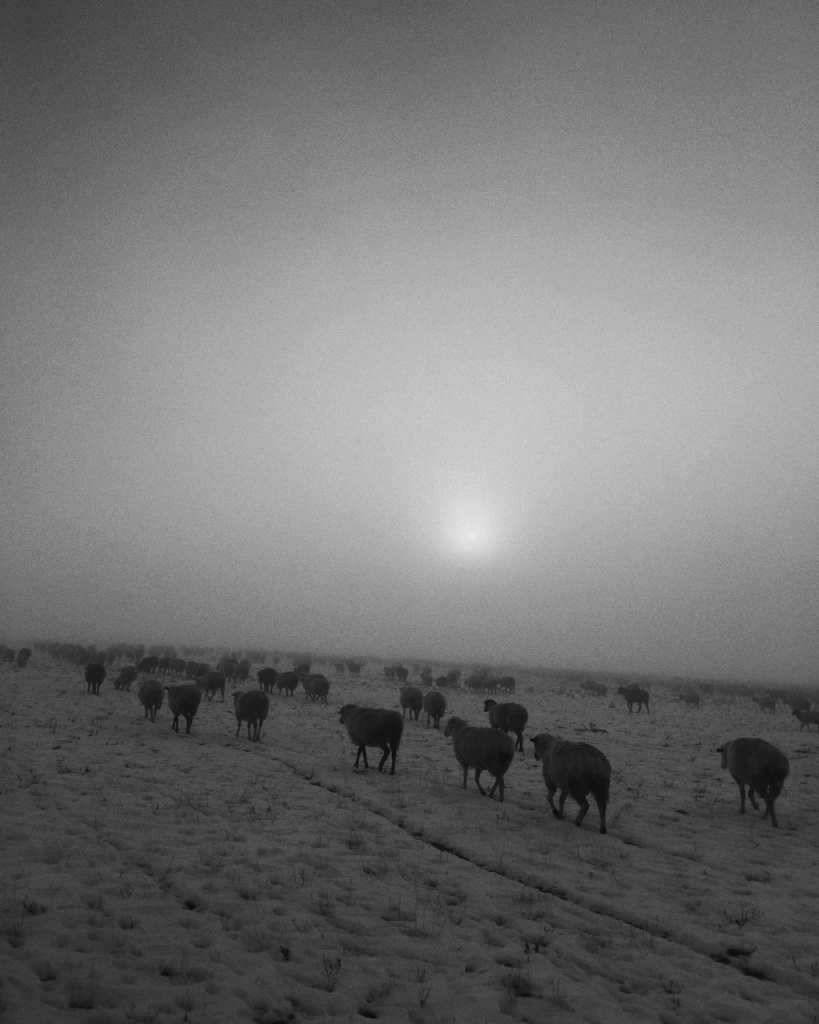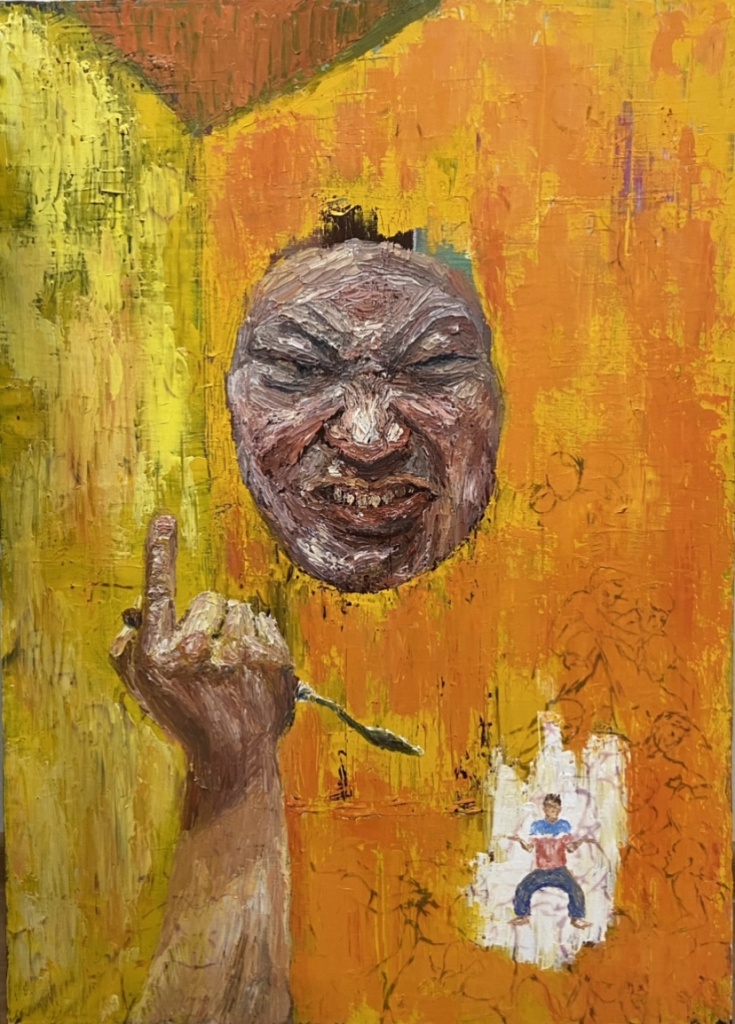
CURATED BY KATHERINE LEUNG
The Republic of Kalmykia is one of the least-populated ethnic republics in European Russia. Kalmyks are primarily Buddhist, draw lineage from the Mongols, and share a robust folk tradition of costume-making, decorative arts, and national jewelry. But this exhibit is not about the Kalmyks of the past but instead, a collective of twelve artists working hard to shatter stereotypes and redefine Kalmyk aesthetics.
Four artists – Gerel Puteeva, Kristina Dobr, Victoria Sarangova, and Gerel Erendzhenova – put together the first ever contemporary Kalmyk art exhibition, titled Mu. Mu means bad in the Kalmyk language, which was fitting for the untraditional format of the art show. They brought together a diverse group of creatives, anyone who identified as Kalmyk and felt like their voice had a place at this group show. Mu was on view at the Amur-Sanan National Library in Elista October 3-6th, 2021.
Kalmyk Contemporary spotlights some of the up-and-coming talent from the diaspora and some of the participants of Mu. Many of these artists take on intersectional activist identities, with much to say about life as a minority in a majority white and Russian country. Photographers, painters, illustrators, designers, models, creative directors, curators, and more come together to share their vision for contemporary art. Lossi 36’s Kalmyk Contemporary is merely an anthology of their ideas and a collection of interviews from some of the republic’s most hopeful voices.
ILLUSTRATORS
I like “Pooping is hard” because this piece is portraying the balance between meme-like algorithms and senseless perception locked in emotions like laughing, giggling or condemnation, disapproval. For me this picture is more humanistic and “alive” than anything in the digital world.
More and more often, my friends and acquaintances who need psychotherapy turn to me, and seek advice on finding a psychologist. I fully support them and try to convey that it is not shameful and that it’s normal to go to a psychologist. The main thing is you are comfortable and find comfort in your well-being. I am always happy to help everyone, especially since I understand how terrible it is to be afraid of being misunderstood and how important the topic of mental health is.
PHOTOGRAPHERS
My initial idea was to create a movie. I had to postpone that idea for the future, due to lack of skills and gear. I only took my camera with me and tried to capture as many moments of life as I could. And there were more moments to remember than I could record. One month is definitely not enough to fully embrace it.
Kalmyks historically were nomadic shepherds. Farms, ranchos or farming spots are called «точка» or “tochka” in Kalmykia. Tochka is usually placed in the middle of a steppe remote from the villages and towns. I started to work at a tochka in summer 2014, right after graduating from university. Back then I was eighteen and dreamed of a military career.
I really like to experiment with prism lenses in my street photography. It is especially spectacular looking when you shoot something bright and colourful. One of the most popular showplaces in Elista is the The Seven Days Pagoda.
PAINTERS
A tired, sad and desperate stare directed straight through the horizon. Lonely and melancholic, sometimes detached from reality, sometimes auto-agressive. The Santa suit is meant to show the intentions of the viewer to please every single person without any greed. The combination of the ski mask and the Santa suit is supposed to reflect part of myself – taking or stealing someone’s sadness and offering them moments of happiness instead.

Moscow, Russia

The first dance in the yellow-orange space
Acrylic, acrylic lacquer on canvas, 60×80 cm
I am extremely aware of the fact that I am now the face of my home Republic, that’s why I try to look at everything in life through that prism. And it doesn’t matter if I wanted that title or not, what’s more meaningful to me is to be someone bringing light. I think it’s important to understand that everyone on this earth is the face of our planet.
Most Russians do not know much about Kamlymia. It’s hard to believe that people aren’t aware of entire republics inside their own country. However, I’m also a supporter of increasing the popularity of Kalmyk culture and our accomplishments. We’ve lost our writing and almost all of our language. I very much do not want to lose Kalmyk culture.
MIXED-MEDIA
It was my first opportunity to show it in Kalmykia. The work itself is a series of four portraits, hand embroidered. Each one is a portrait of a woman that represents a particular stage in Kalmyk history.
I chose this particular hand embroidery to showcase because I wanted to go through the process of reflecting through history that I wasn’t familiar with and wanted to personally learn. In this process, I found out that I did know a lot about myself and my republic. The reason it’s called “Motherland” is because the fourth portrait is my mother. She died in 2010 so it is a very personal work for me.
I felt like my experience from visiting Kalmykia has changed as I was slowly starting to accept my heritage. At first, after moving to Moscow as many other Kalmyks do, I felt not only disconnected from Kalmykia, but also ashamed of my otherness, non-whiteness, of coming from “nowhere”, of a place many people don’t even know is a part of Russia. On the other hand, when I visited Kalmykia, I felt like it was sad, small, and poor. I’m ashamed to admit that I even felt sorry for people who lived there. Later I realised it all comes from internalised racism, nationalism, colonialism, and I started reconnecting with my homeland. When I visited this year in May, Kalmykia suddenly seemed soft, kind, and radiant.
ANIMATION

Elista, Russia
IDOLS. Stolen time
Animation
I often question the reality of our beliefs. The world that we see and perceive is built on the basis of our life experience and the experience of a society in which we coexist with other people. What happens if one of the realities is taken away from us?
















